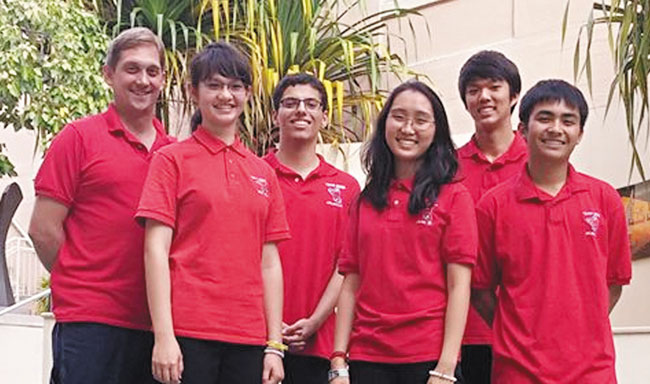Falcons Design Drone Operation Judged Best In State
Designing a drone is a challenging task. Designing a drone that specifies how to revolutionize farming — and develping a business plan for its potential sale — is even hard- er. But five Kalani High School students were up for it, taking first place in state competition for the Real World Design Challenge in April.

Team adviser Bryan Silver, (from left) Camelia Lai, Fabrice Rosala, Lee Danielle Young, Conrad Pak and Kevin Williams. PHOTO FROM BRYAN SILVER.
Juniors Camelia Lai and Lee Danielle Young, and seniors Fabrice Rosala, Conrad Pak and Kevin Williams must now prepare for the October national competition in Washington, D.C.
Team adviser Bryan Silver explained that there are a lot of elements at play in the RWDC, which sees high school students using industry-standard programs and equipment, such as Mathcad, PTC Creo 2.0 and Windchill, to build and test models in virtual reality before generating a report about their design process.
This year’s challenge was to create a precision agriculture drone. “The idea is that this drone will disperse pesticide onto crops,” said Silver. “So they had to figure out how they would disperse pesticides, or use the drone to have pesticides dispersed onto the crops in order to target pests.”
Myriad details had to be factored into the design: how the drone would identify pests, battery life, carrying weight, farmer expectations for the drone and so forth. The team summarized its work in a 45-page report and 20- minute presentation before a panel of judges — and the victory was extra sweet this year, Silver said. “They felt pretty darn excited about (winning). In the seven-year history (of RWDC in Hawaii), we’re the only public school who has made it to the top three all seven years. This is the first time we’ve been able to make it to first place.”
That Kalani has had a track record of success here isn’t surprising at all to Silver. He pointed out that Kalani engineering and robotics students already are familiar with the programs used in RWDC as part of their normal curriculum, so they immediately can begin learning advanced functions instead of basics.
Silver also cites a flexible attitude. Students research every step of the process and revise their ideas with the new information they gather. It’s a continuous cycle of reeval- uation that goes on throughout the entire project.
“That’s what Kalani’s done that’s been successful. And we just keep at it. We have fun at it, we don’t stop and we never give up; no matter how hard it is, or what problems we run into, we find a solution and work around it.”





